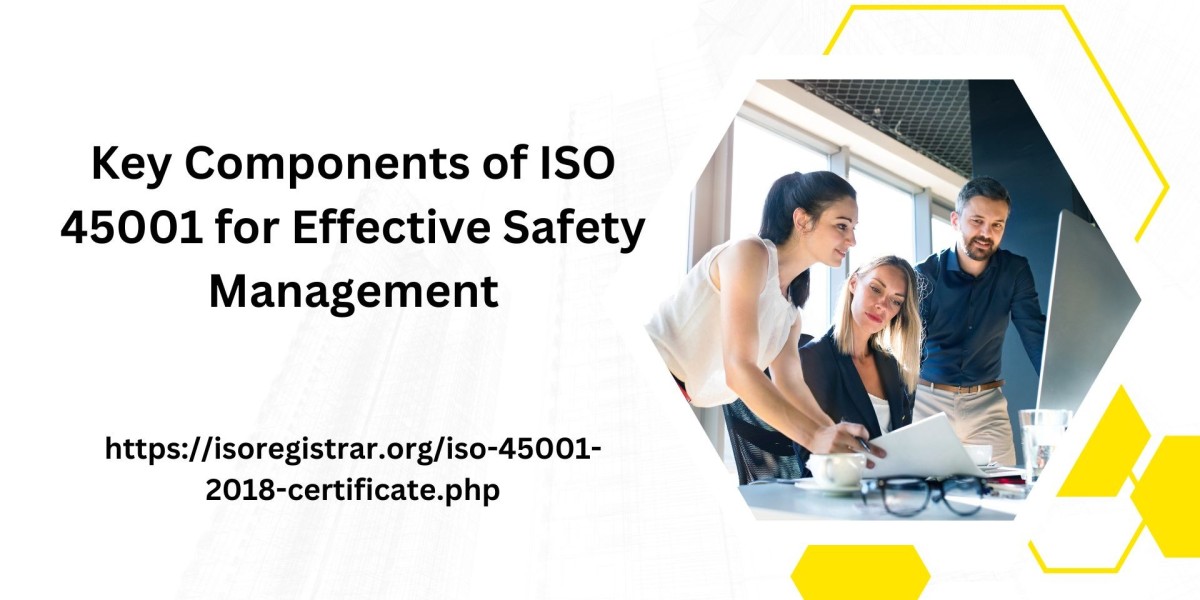ISO 45001:2018 is the international standard for occupational health and safety (OHS) management systems. Its purpose is to help organizations improve employee safety, reduce workplace risks, and create safer working environments. By adopting ISO 45001, businesses can establish a systematic approach to managing health and safety risks, ensuring continuous improvement in their safety practices. This article outlines the key components of ISO 45001 certification that are crucial for effective safety management.
Key components of iso 45001 certification
1. Leadership and Worker Participation
One of the core components of ISO 45001 is strong leadership and active worker participation. The standard emphasizes that effective safety management starts with leadership commitment from top management. Leaders are responsible for setting safety policies, providing resources, and ensuring that health and safety objectives are aligned with overall business goals.
However, leadership alone is not sufficient. ISO 45001 stresses the importance of involving workers at all levels in health and safety processes. Workers are often the best source of information about hazards in the workplace and can provide valuable insights into improving safety practices. ISO 45001 encourages a participative approach, where employees are empowered to contribute to decision-making, risk assessments, and safety initiatives.
2. Hazard Identification and Risk Assessment
ISO 45001 requires organizations to proactively identify hazards in the workplace and assess the risks associated with these hazards. The first step in effective safety management is to recognize potential dangers that could harm workers. Hazards can be physical (e.g., machinery), chemical (e.g., exposure to toxic substances), biological (e.g., bacteria or viruses), ergonomic (e.g., repetitive strain), and psychosocial (e.g., stress or harassment).
Once hazards are identified, the organization must assess the risks to determine the likelihood of harm and the potential severity of that harm. Risk assessments are a critical component of ISO 45001, as they help prioritize which hazards require immediate attention and which can be managed over time.
3. Risk Control and Mitigation
Once hazards and risks are identified, ISO 45001 outlines a systematic approach to controlling and mitigating those risks. The standard emphasizes the hierarchy of controls, which is a priority list for controlling risks in the workplace. The hierarchy includes the following measures:
Elimination:
If possible, remove the hazard entirely. For example, eliminating a dangerous chemical from the workplace.
Substitution:
Replace a hazardous substance or process with something safer. For instance, substituting a toxic solvent with a less harmful alternative.
Engineering controls:
Implement physical modifications, such as safety guards on machinery, or ventilation systems to reduce exposure to hazards.
Administrative controls:
Modify work practices, such as implementing safe work procedures, providing training, or rotating employees to reduce exposure to hazards.
Personal protective equipment (PPE):
As a last line of defense, provide employees with PPE (e.g., helmets, gloves, respirators) to protect against residual risks.
This structured approach helps organizations systematically reduce workplace hazards and protect workers’ health and safety.
4. Objectives and Performance Evaluation
ISO 45001 requires organizations to set clear health and safety objectives that align with their overall business goals. These objectives should be specific, measurable, achievable, relevant, and time-bound (SMART). By setting objectives, organizations can focus their efforts on critical areas of improvement, whether that be reducing accident rates, improving employee safety training, or enhancing safety awareness across the organization.
The standard also stresses the importance of measuring safety performance. Organizations must develop key performance indicators (KPIs) to track progress and evaluate the effectiveness of their health and safety management system.
5. Compliance with Legal and Other Requirements
ISO 45001 requires organizations to stay up-to-date with local, national, and international health and safety regulations. Compliance with applicable laws is a fundamental component of an effective safety management system. The standard ensures that organizations are aware of their legal obligations regarding worker safety and that they take necessary actions to comply with those obligations.
In addition to legal requirements, ISO 45001 encourages organizations to consider other safety-related requirements that may apply to their specific industry or sector. This could include industry best practices, standards, or agreements with trade unions or employee representatives.
6. Emergency Preparedness and Response
Every workplace must be prepared for potential emergencies, whether it's a fire, chemical spill, natural disaster, or medical emergency. ISO 45001 requires organizations to develop and implement emergency preparedness and response plans. These plans should be tailored to the specific risks and hazards present in the workplace.
Key elements of an emergency response plan include clearly defined roles and responsibilities, procedures for evacuating employees, emergency contacts, and the availability of first aid and emergency equipment.
7. Continuous Improvement
Continuous improvement is a fundamental principle of ISO 45001. The standard encourages organizations to continuously evaluate and improve their health and safety management system. This approach ensures that safety practices evolve and remain effective in addressing new risks and challenges.
The Plan-Do-Check-Act (PDCA) cycle is a key tool in ISO 45001 for driving continuous improvement. The PDCA cycle encourages organizations to plan their safety objectives and processes, implement them, check their effectiveness through monitoring and audits, and take corrective actions where necessary.
8. Documented Information and Record Keeping
ISO 45001 requires organizations to maintain appropriate documentation and records related to their health and safety management system. This includes policies, procedures, risk assessments, training records, inspection reports, and audit results. Effective record-keeping ensures that the organization can demonstrate its commitment to safety, track progress over time, and provide evidence of compliance during audits or inspections.
Documented information also facilitates communication between departments, management, and workers, ensuring that everyone is informed about safety policies, procedures, and responsibilities.
Process of iso certification
Step 1: Go to isoregistrar.org, the official website.
Step 2: Complete the online application and submit it.
Step 3: You will be shown a number of payment choices when your application has been received. To move on to the following steps, finish the payment.
Step 4: Following payment processing, you will need to upload the necessary documents, which include a recent purchase or sales invoice, your GST number, and your UID and PAN cards. Our website has further details regarding the necessary paperwork.
Step 5: To start the certification process, an expert will get in touch with you.
Step 6: You will get an email with your ISO certificate in 3 to 5 business days.
Note: Applying for iso 9001 certificate- quality management systems
Conclusion
ISO 45001 provides a comprehensive and systematic approach to managing health and safety risks in the workplace. By focusing on leadership, worker participation, hazard identification, risk control, compliance, and continuous improvement, the standard helps organizations create a safer and healthier work environment. The key components of ISO 45001 are designed to be adaptable to any organization, regardless of size, industry, or location, making it an invaluable tool for achieving long-term safety success. By embracing these components, organizations can reduce workplace accidents, protect their workforce, and enhance their overall operational efficiency.










